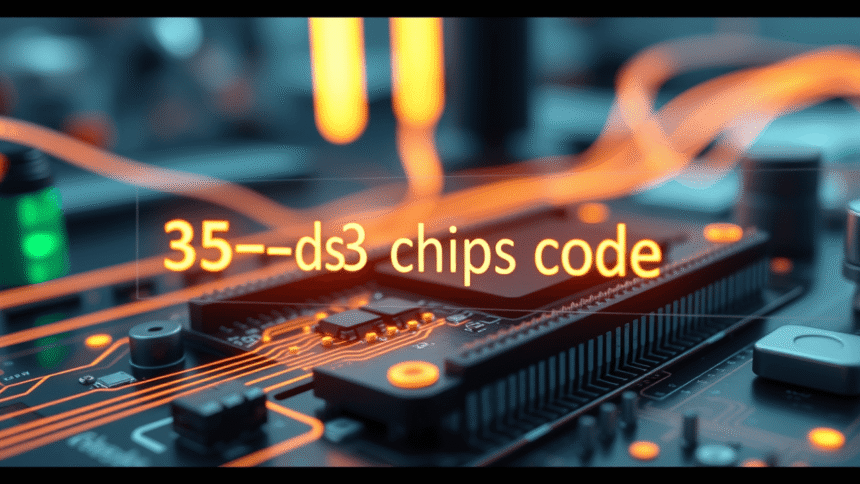Understanding and working with the 35‑ds3 chips3 code can be a game changer for developers working with embedded systems or hardware programming. Whether you’re a beginner exploring microchip firmware or an experienced engineer troubleshooting your setup, having a detailed grasp of this code is essential. This guide walks you through everything you need to know—from configuration and components to common issues and expert insights—using the 35-ds3 chips3 code effectively.
What is 35‑ds3 chips3 code and Why Does It Matter?
The 35‑ds3 chips3 code refers to a specific set of instructions or configuration protocols used primarily in chip-based hardware systems. These are generally used for interfacing with microcontrollers, sensors, or programmable boards in industrial and consumer electronic devices. Understanding how this code functions is crucial for anyone developing or maintaining embedded solutions.
This code plays a role in:
- Setting up chip-to-chip communication.
- Handling memory addressing and voltage compatibility.
- Managing timing sequences and control lines.
By mastering the 35‑ds3 chips3 code, you not only make your hardware setups smoother but also minimize troubleshooting time and system errors.
How the 35‑ds3 chips3 Code Works in Embedded Systems

When applied in embedded system environments, the 35‑ds3 chips3 code works as a low-level communication layer between the core processor and peripheral modules. Its primary function is to ensure stable interaction, precise timing, and effective data exchange. It usually sits somewhere between firmware and hardware and must be integrated accurately to avoid system instability.
Code Structure and Components
The 35‑ds3 chips3 code consists of modular components that handle the following:
- Initialization Protocols: Define the order in which chip components boot or communicate.
- Memory Map Setup: Assign addresses to internal and external memory units.
- Control Signals: Manage pin directions, states (HIGH/LOW), and voltage thresholds.
Each component works in conjunction with the others. A misconfiguration in even one segment can cascade and cause issues like system halts or unexpected behavior.
Communication and Bus Types
Depending on your setup, the 35‑ds3 chips3 code may interface through:
- I2C (Inter-Integrated Circuit)
- SPI (Serial Peripheral Interface)
- UART (Universal Asynchronous Receiver-Transmitter)
Each communication type has its own set of timing requirements and electrical specifications. Always ensure compatibility when selecting your microcontroller or sensor.
Step-by-Step Setup Instructions for the 35‑ds3 chips3 Code

Setting up the 35‑ds3 chips3 code properly ensures that your chips communicate and function correctly in the embedded system. Here’s how you can go about it:
Step 1 – Verify Your Hardware Compatibility
Make sure your chip modules, power supply, and connectors match the specs outlined in the datasheet. Look for:
- Voltage range
- Supported communication protocols
- Clock frequency
Step 2 – Install Required Software Tools
You’ll need a code editor, compiler, and flash tool. Some popular choices include:
- MPLAB X IDE for Microchip devices
- Keil µVision
- STM32CubeIDE
Step 3 – Configure Your Pin Mappings
Set up the I/O pin configurations in your code. For example:
TRISBbits.TRISB0 = 0; // Set RB0 as output
LATBbits.LATB0 = 1; // Drive RB0 highStep 4 – Write and Upload the Code
Once configuration is complete, compile the code and flash it to your board. Run a test cycle to verify everything functions as expected.
Step 5 – Monitor Logs and Debug
Use a serial monitor or debugger to catch any system errors. Analyze logs to determine where issues might be occurring.
Common Issues with 35‑ds3 chips3 Code and How to Fix Them
Working with microcontrollers can be frustrating if things don’t work right out of the box. Here are the most common problems related to the 35‑ds3 chips3 code and how to resolve them.
| Issue | Cause | Solution |
|---|---|---|
| Pin Mismatch | Wrong port configurations | Cross-check with pin diagram |
| No Communication | Incorrect baud rate or wiring | Ensure correct protocol and clock settings |
| Compiler Errors | Syntax or dependency issues | Review documentation and use correct headers |
| Device Not Responding | Power supply issues or fried ICs | Test with multimeter, replace if needed |
Tips to Avoid These Problems
- Always refer to the latest datasheets and wiring diagrams.
- Use logic analyzers to visualize signal timing.
- Keep code modular and well-commented.
Best Practices for Maintaining and Updating Your Code
To ensure long-term reliability and scalability of your embedded application, follow these maintenance practices:
- Version Control: Use Git or similar tools to track changes and roll back if needed.
- Code Documentation: Write comments, README files, and usage guides.
- Regular Testing: Implement unit tests and simulate edge cases.
Optimizing Performance
Here are a few tips to optimize your 35‑ds3 chips3 code:
- Reduce polling-based logic; prefer interrupts.
- Optimize memory allocation.
- Use compiler optimization flags during build.
Lifecycle Management and Updates
To keep your embedded systems future-proof, plan for regular firmware updates. Consider implementing OTA (Over-the-Air) updates if the system supports it. Always test firmware on backup hardware before deploying to production.
Table: Code Review Checklist for 35-ds3 chips3 Code
| Area | Checklist Item | Status |
| Initialization | Are boot sequences ordered correctly? | ✅ |
| Communication Protocol | Is the correct bus type implemented? | ✅ |
| Memory Management | Is memory usage efficient and leak-free? | ✅ |
| Error Handling | Are exceptions properly handled? | ✅ |
| Documentation | Is the code adequately commented? | ✅ |
FAQs
Q1: What does the 35‑ds3 chips3 code primarily control?
The code manages communication between a microcontroller and peripheral chips, including timing, memory setup, and data transfer protocols.
Q2: Can I use the 35‑ds3 chips3 code with any microcontroller?
Compatibility depends on the protocol and voltage specifications of your microcontroller and peripheral chips.
Q3: Is there a simulation tool for testing the 35‑ds3 chips3 code?
Yes, tools like Proteus or Multisim can simulate embedded systems and help test the code virtually before deploying it.
Q4: How often should I update the code?
You should update your code whenever there’s a hardware change, firmware update, or discovered bug.
Final Thoughts and Insights
Working with the 35‑ds3 chips3 code may seem complex at first, but with the right guidance and structure, it becomes much more manageable. Take time to understand each part of your system and test methodically. With the correct setup, you can achieve reliable and scalable embedded solutions using this powerful codebase.
If you’re looking for more tips on embedded development or chip configuration, bookmark this blog and stay updated with our technical series.
We hope this guide helps you unlock the full potential of your embedded systems using the 35‑ds3 chips3 code. Happy coding!
Also read: aviyne .com: A Comprehensive Guide to Its Innovative Digital Platform

